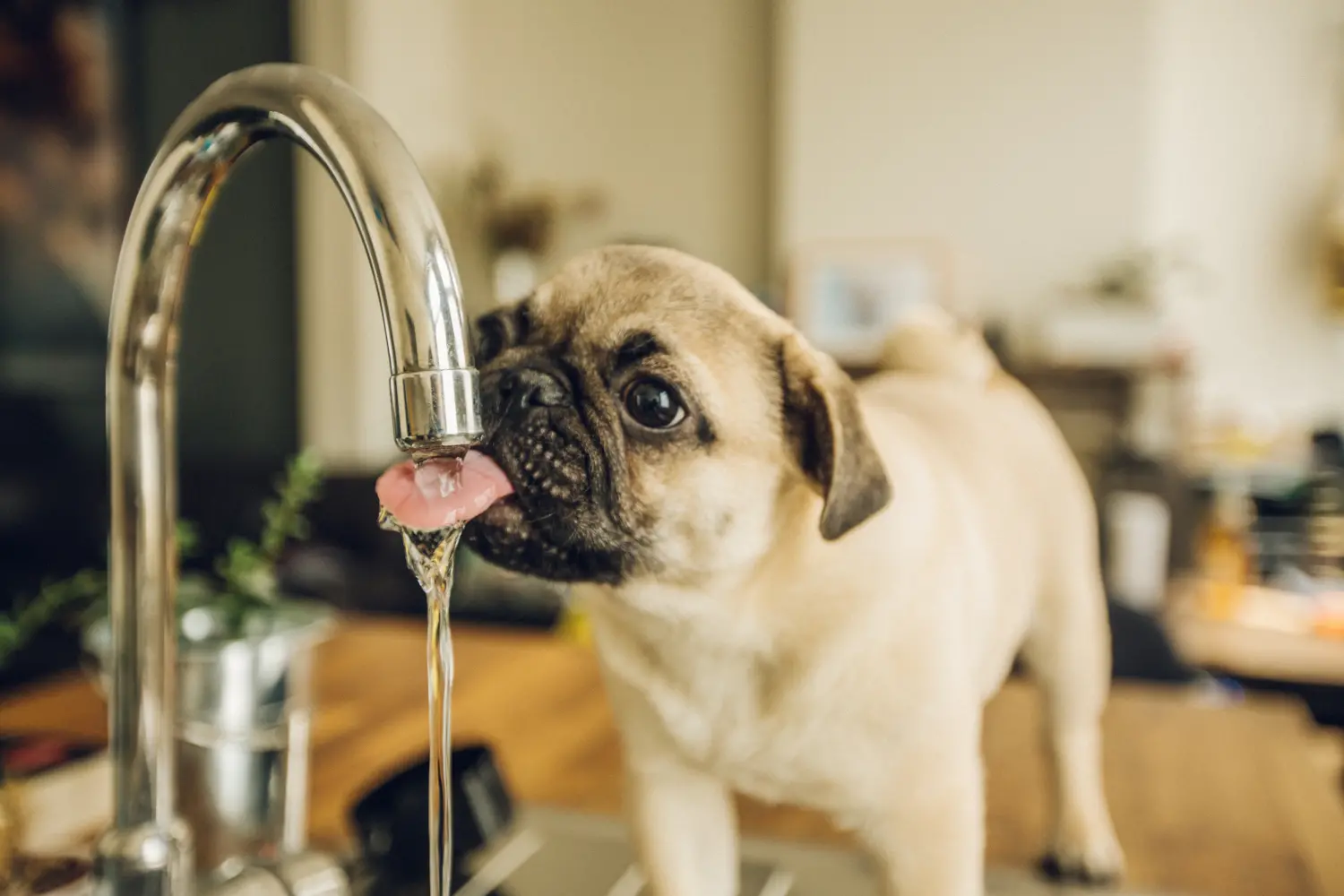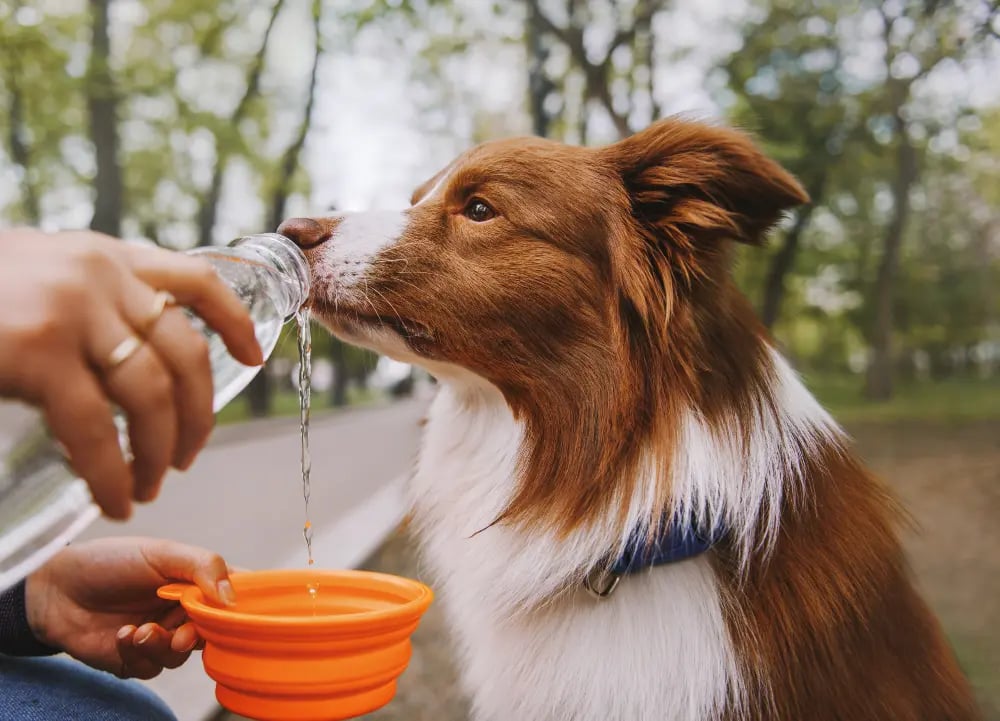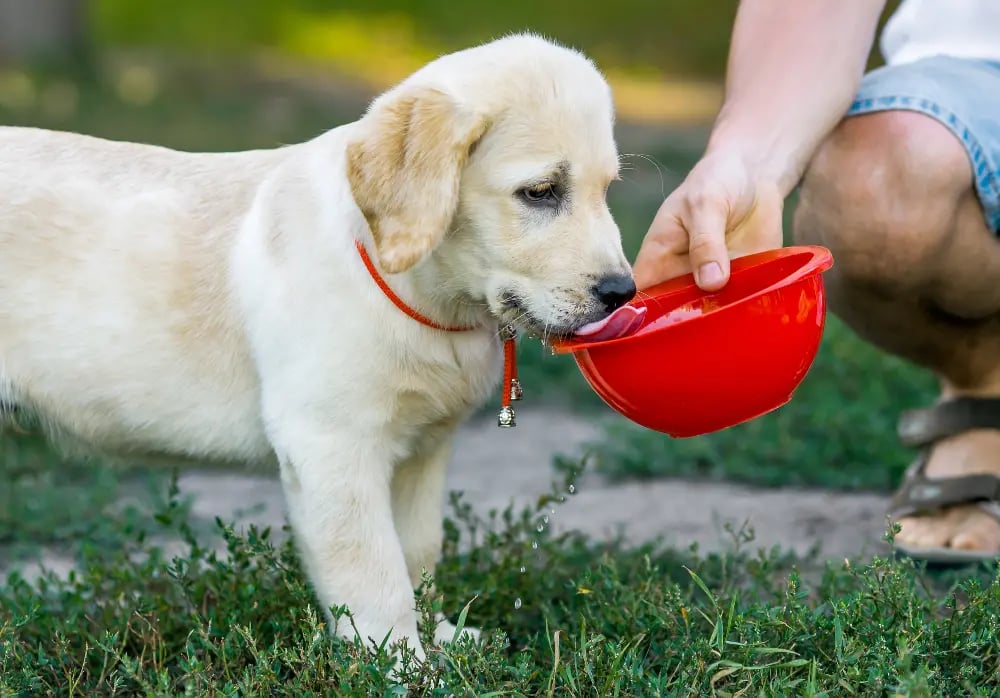
Is your dog drinking enough water? Proper hydration is the foundation of your dog’s good health, and most dogs don't drink as much water as they should. Learn how to get your dog to drink more water.
How can you tell if your dog is drinking enough water? You see them take a sloppy drink from their water bowl, but is it enough?
In this article, we'll discuss not only how to tell if your dog is drinking enough, but you'll learn some clever tips for getting more water into your dog on a daily basis.
Your canine might not be drinking a sufficient amount of water for a variety of reasons. However, it is never normal for a pup to completely refuse water.
If your dog will not drink any water, then you should seek emergency medical care from your veterinarian.
What Causes a Dog Not to Drink Water?
If you’re in search of a way to get your dog to drink more water, it’s important to get to the root of the problem first and understand what causes a dog not to drink water. Once you’re able to determine the cause of the reduced water consumption, then you can look at ways to fix the problem.
Reasons why your dog is not drinking water can include:
Natural Ageing
Many older dogs simply don’t have the energy needed to drink water. The canine might feel thirsty, but it takes too much work to drink an excessive amount of water. Often, the aging dog simply doesn’t drink much water because the canine doesn’t exercise very much.
Providing your aging dog with delicious wet food or raw food can help improve your dog’s water intake as well as encourage a picky eater to eat. Many senior dogs suffer from dental issues, which can make it difficult for them to chew dry kibble, so wet and raw foods are ideal choices.
Wet dog foods not only have a higher moisture content but are also high in protein with low carbs. The added protein helps meet the nutritional needs of a senior dog with a slow metabolism.
Dirty Water
Canines have an acute sense of smell and taste. They can easily detect smells that humans cannot. If the water smells foul or is tainted in some way, then the dog might refuse to drink.
Sometimes a dog’s bowl will become dirty. Food particles get dropped into the water if the dog takes a bite of food and then tries to drink. As the food spoils, your doggo might not want to go anywhere near their dog bowl, let alone drink from it. Also, water that contains high amounts of iron might not appeal to your canine.
Always ensure that your dog has access to fresh water. Consider investing in a water fountain to encourage interest in drinking water and keep the water fresh. Many dogs and cats prefer to drink only from flowing water versus stagnant. It is the canine’s natural instinct to drink from running water which harkens back to the animal’s wolf ancestry.
Flowing water in streams and rivers is typically cleaner with fewer bacteria. The motion of the running water maintains aeration while preventing bacterial growth, which your dog might find unpalatable.
Dehydration from Inadequate Water Consumption
Is your dog drooling or panting excessively? Does the animal have red, sticky or dry gums? When you pinch your dog’s skin, lift gently upward, and release, does the skin snap back into shape or take time to return to normal? Slow skin elasticity is another key indicator of dehydration.
If your dog is dehydrated, then you don’t want him to drink an excessive amount of liquid too quickly, or he might vomit. Only provide small amounts of water to prevent your dog from drinking too much.
When it is excessively hot, try to hydrate your dog slowly by providing DIY frozen treats. Always ensure that your pet has access to clean, fresh water. You also might want to invest in a cooling vest to prevent your dog from becoming dehydrated and help keep your pet cool by maintaining the animal’s core body temperature.
Injury or Illness
If your dog is ill or injured, then she might not consume an adequate amount of food or water. Oral injuries, periodontal disease, tooth abscess, infection or damaged teeth can become painful when exposed to water, and your dog will shy away from drinking.
Another common dog illness that could affect drinking is a UTI. Urinary tract infections in dogs can impede the flow of urine, and the pain reduces the dog’s thirst making the animal refuse to drink.
If you suspect your dog is not drinking a sufficient amount of water due to an injury or illness, then you’ll need to contact your veterinarian to determine the cause of the problem.
How to Get Your Dog to Drink More Water

One of the most common complaints a veterinarian hears is that an owner is concerned about ‘my dog not drinking much water.’ Many dogs simply do not drink a sufficient amount of water each day. However, there are ways that you can increase your dog’s water intake.
1. Feed Wet Food
The best way to keep your dog properly hydrated is to feed them a diet rich in moisture. In the wild, dogs get most of their water intake from fresh, raw dog food, so it makes sense that domesticated dogs should get their water the same way.
Fresh, raw dog food is high in moisture and can keep your dog more hydrated than just leaving out fresh clean water.
Canned dog food can also add additional moisture. It can be fed as a complete diet or in combination with a dry diet.
2. Use Moisture Rich Food Toppers
No matter what type of diet you feed your dog, adding a little extra moisture with a tasty dog food topper will ensure your pup stays hydrated. Creamy Goat's Milk, nutritious Pet Milk, or savoury Bone Broth are all great options.
3. Try Wet Dog Treats
Treats are another way to get additional moisture into your dog. Tasty snacks like Puppy Cake Dog Ice Cream or This & That Brothcicles will offer moisture to your dog in an irresistible sweet treat.
Homemade frozen dog treats recipes are also a fun way to encourage your dog to take in more water. Check out our Top Frozen Dog Treat Recipes for some inspiration.
4. Feed Fresh Veggies and Fruits
Many vegetables are high in moisture, so feed fresh ground veggies as part of your dog's meal or as a treat. Some of the most moisture-rich dog-safe vegetables and fruits include pumpkin, cucumber, tomato, spinach, and melon.
5. Use a Dog Water Fountain
Dog water fountains can be a great tool to encourage your dog to drink more water. They are filtered, keeping out debris and odours that can happen with stagnant water bowls. The movement of the water can also help to keep the temperature down by a degree or two.
6. Always Keep Water Close
Both in your home and out, fresh, clean water should always be available. Having multiple water sources in your home, a dog travel bowl for long car rides, and a dog water bottle for walks can ensure that your dog can always get a drink when he needs one.
7. Add Flavour to Their Water
Making their water taste a little better could be a great way to encourage your dog to drink more. A little bit of broth in their water can help, but don't bother mixing a large amount. Add a tsp of bone broth to a small portion of water and offer it to your dog. Whatever is not drunk right away should be refrigerated.
You should still keep a separate fresh clean bowl of water that can sit out all of the time. Once you've added a food product to it, it can go bad quickly.
8. Build a Routine
Encouraging your dog to drink water should be done routinely throughout the day. After their first pee break of the day, after a walk, after a game of vigorous play, and after meals are all great opportunities to bring your dog to his water dish and ask if he wants a drink.
In time and with repetition, your dog will instinctively seek out his water bowl several times per day.
9. Keep it Clean
Your dog's water bowl can get messy and dirty fast. Dirt, debris, hair, and bacteria in your dog's water dish can make the water taste bad. Replacing the water with fresh clean water daily can help prevent bad flavours and odours, and sanitizing the bowl once per week can reduce slimy build-up and harmful bacteria.
10. Eliminate competition
In multi-pet households, sharing water dishes can lead to competition and make timid dogs hesitant to partake. Having multiple bowls can help, but having bowls that are more accessible to some pets than others can reduce competition.
Bigger pets can benefit from raised dog bowls to reduce the crossover with smaller pets. You can also try keeping water bowls in separate areas of the house that each pet prefers.
Why a Dog Needs Sufficient Water
Water is considered the fourth "unwritten" macronutrient. We know that a good dog diet needs to be made up of protein, carbohydrates, and fats, but water is the fourth piece of that puzzle.
Water is necessary to support digestion, nutrient distribution, healthy skin and coat and much, much more.
Better Digestion
Dogs require sufficient moisture for proper digestion. The water in the intestinal tract helps to form stool and make sure that food is broken down at an appropriate speed.
Flush Out Toxins
Water naturally flushes out toxins from the body, which is a benefit if your pet is ill. It can also help if your dog has consumed tainted or old foods that could upset his digestive tract. Dogs are notorious scavengers who enjoy raiding garbage or finding edible morsels outside that might not agree with them.
Replenishes Body Fluids
If your dog is sick, then it can quickly lose body fluid through diarrhea or vomiting. You’ll need to keep your furry friend hydrated by providing fresh, clean water.
Water As a Necessity for Survival
All mammals require water to survive. Without water, your dog can quickly become dangerously dehydrated. If your pup refuses to drink, then you’ll need to seek veterinary care.
How to Get a Dog to Drink Water FAQ

If you are struggling with how to get your dog to drink more water, then the answers to these frequently asked questions might help you better understand and overcome the problem.
Why will my dog not drink water?
Your dog might not drink water for a wide range of reasons, such as sickness or problems with the water being dirty. Senior dogs often will not drink a sufficient amount of water due to dental problems, or they simply do not feel like getting up to go to the water bowl.
How long can a dog go without water?
When a dog becomes ill, their appetite and desire for water often vanish. A sick dog often cannot hydrate sufficiently. A mammal can only go three days without water, so if your dog is not drinking water, then you must immediately take the pet to the veterinarian.
How can I treat dehydration in my dog?
Provide your pup with foods that are electrolyte rich such as pumpkin puree, bone broth, or wet dog food. Avoid dry foods like kibble, as they can contribute to dehydration. Always ensure that your dog has ample access to fresh and clean water.
Why does my dog eat but not drink water?
If your dog gets sufficient moisture from the diet, then additional water intake will be needed less frequently, but for dogs eating a dry diet, like air-dried or kibble, not drinking water is a red flag that may require further investigation.
How much water should a puppy drink?
On average, a young puppy will drink half a cup of water every few hours. Older puppies may drink from half an ounce to an ounce of water per pound of body weight. This may change depending on temperature, diet, and activity.
Can I flavour my pup’s water?
Flavouring your pet's water may encourage your dog to drink, but be careful what you add. Artificial flavours and sweeteners are bad for dogs and, in some cases, extremely toxic. Instead, opt for natural flavours like bone broth, and be prepared to refrigerate the water to prevent spoilage.
A Hydrated Pup is a Happy Pup
Ensuring that your dog stays hydrated is a labour of love. Your furry friends need sufficient water each day to help regulate body temperature, bolster the immune system, keep organs functioning properly, deliver nutrients to cells, and keep joints lubricated.
Staying properly hydrated improves your dog’s mood and cognition to ensure a long life and a happy, healthy pet.
.png?width=200&height=66&name=logo%20(1).png)




